
views
Planting Seeds

Purchase or gather morning glory seeds. Buy packaged seeds, or collect the seed pods from a friend's morning glory plant. As morning glory flowers die, they leave behind round seed pods at the base of the flower stem. The pods are ready to pick when they turn papery and brown, and contain dark brown or black seeds. Morning glories cross-pollinate, meaning that plants grown from seed will not necessarily look much like the parent once they grow.

Plant seeds after the last frost. If planting outdoors, wait until the last frost has passed and the soil has begun to warm. If you'd like to start the morning glories indoors, plan on starting 4–6 weeks before the last frost. Depending on your local conditions you may be able to plant in late summer if you tend to have mild winters. If it gets cold in September, you probably shouldn't plant. If storing seeds over the winter, keep them in a dry, dark location.

Scratch or soak the seeds (optional). Some morning glory seeds are too hard to germinate quickly without help. Most growers either nick the seed with a nail file, or soak the seed overnight in room temperature water, in order to increase the odds of success. Often, you'll have so many seeds on hand that you can skip this step and accept that not all seeds will germinate. Some gardeners argue that soaking can cause rotting or infection, and that shallow planting in moist soil will produce similar results with less risk.

Select a permanent growing container or garden spot. Morning glories react poorly to transplanting due to their delicate root systems, so it's best to pick one location and stick to it. If planting in an outdoor container, choose one at least 2 ft (0.6m) wide and 3 ft (0.45m) high for best results. If starting the plant indoors, use a 3 inch (7.6cm) peat pot that can be buried in your garden when you want to move the plant outdoors. Morning glories can be directly seeded outside successfully.
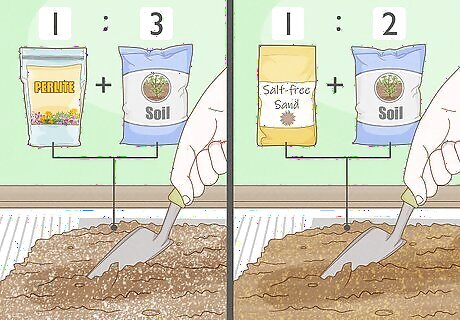
Prepare a well-draining soil. Adult morning glories are very tolerant of poor soil conditions, but the seeds need a well-draining growing medium. To achieve this, mix 1 part perlite with 3 parts soil, or mix 1 part salt-free sand with 2 parts soil. Do not mix sand with clay-heavy soil. There's no need to grow these in extra-rich, fertile soil. Rich soil can even lead to fewer flowers in some morning glories, notably "Heavenly Blue" and other Ipomoea tricolor varieties.

Plant in shallow holes. Plant each seed in a ½ inch (1.25cm) hole and cover lightly with soil. If planting them directly in a garden plot, spacing depends on the variety's size and on personal preference. Consider planting the seeds 2 inch (5cm) apart, then culling to 6–12 inches (15–30cm) apart once the seedlings reach 3 inches (7.5cm) high. At this height, the seedlings are well-established and less vulnerable to pests.
Caring for Seedlings
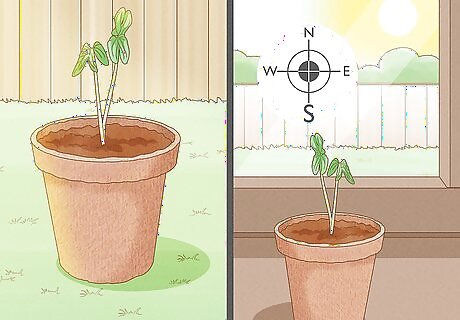
Expose to full sun. Morning glories love sunshine, and will only tolerate very light shade. They should receive as much direct sun as possible, especially while the seedlings are young. Keep indoor plants near a south-facing window (or a north-facing window if you live in the Southern Hemisphere). The ideal soil temperature for germination is about 68–86ºF (20–30ºC).
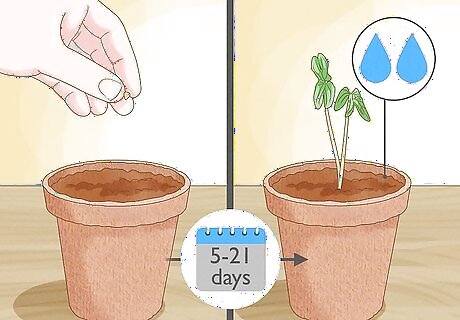
Keep the soil moist until the true leaves appear. Young morning glories may fail to sprout or die if the soil dries out. Keep the soil moist, but not soggy, and wait for germination within 5–21 days (but usually within a week). The seedlings are less vulnerable once the first true leaves appear. (The first leaves to appear are called cotyledons, and look noticeably different than the true leaves.)
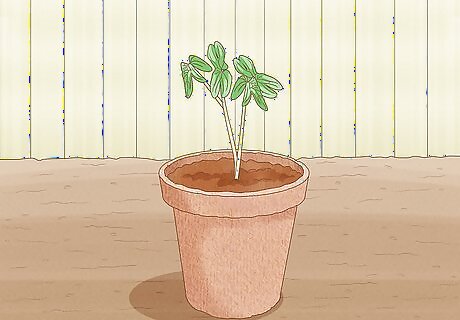
Move them outdoors (if necessary). If you started your plants indoors, move them outdoors once the seedlings are well-established and the last frost is past. Morning glories are hardier than most plants, but it's still a good idea to start by moving the container to partial shade. Move the plant to a slightly sunnier location every few days, or back to darker shade if you see wilting or sun scorch. Keep the soil moist during this acclimation period.

Provide climbing structure as they grow. Once the seedlings are about 6 inches (15cm) tall, provide a stake or trellis for the vine to climb. Alternatively, plant seedlings in a hanging basket and allow the vines to cascade over the edge.
Caring for Established Morning Glories

Water your morning glory sparingly. Adult plants are very tolerant of dry soil, and may not even require watering at all in wet or cool climates. During hot weather, water once or twice a week. Over-watering can lead to excessive vine growth with few flowers.

Provide your morning glory vine with climbing materials. Give them access to a trellis or arbor for shade, or let them grow on a dead tree or post. They cannot climb flat surfaces, so hang plastic netting in front of a wall or solid fence if you'd like the vines to grow there. Give the vines plenty of space; some varieties can grow 15 feet (4.6m) in a single season. Since most morning glory vines die every year, allowing your morning glory to climb living trees is acceptable as the vines will not harm the tree. (Don't try this in areas with mild winters, which morning glories can survive.)
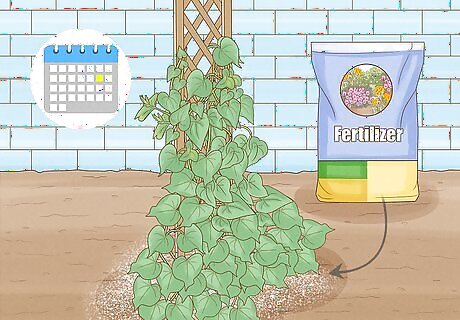
Resist using too much fertilizer. Fertilize when your morning glory is first planted, then no more than once a month during the growing season. If you fertilize too often, you will encourage foliage instead of blooms.

Check for pests occasionally. Since morning glories have few problems with disease, you should find it easy to keep your morning glory plant healthy. Insect problems are also rare, but it's worth the occasional check for aphids and other insects. Your local nursery can help you address the problem if it occurs, usually with an organic pesticide.

Watch the blooming cycle. Morning glories are prolific and long-lasting bloomers, although they sometimes take a month or two to get started. Each individual flower opens in the morning and dies off before the end of the day. This makes morning glories one of the most interesting and beautiful flowers to decorate your garden. Air temperature will alter the color of the bloom and the length of time it stays open.

Clear away dead vines in winter. Morning glories can survive a mild frost, but in most climates they will die in early winter. Morning glories are aggressive re-seeders, which is good and bad news from the gardener. You won't need to buy any more seeds for next season, but you might discover that your whole garden starts growing vines. Clear away the dead vines promptly to prevent this. New seeds will usually grow from the same spot, but you may gather seeds to plant by hand just in case. In warm climates where morning glories grow as perennials, you can grow new plants from short cuttings instead.




















Comments
0 comment